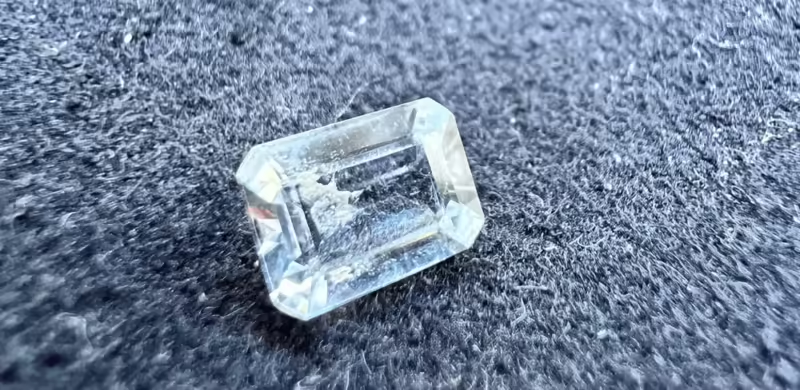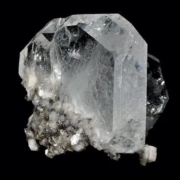Goshenite: Properties, Uses and Virtues
Goshenite: The Mother of All Gems
Goshenite, a variety of beryl, captivates with its immaculate purity and transparent charm.
Less famous than its illustrious sisters, it still shines among stone lovers and enthusiasts. Discover this little-known yet sublime stone!

Goshenite: Table of contents
- Geological Formation of Goshenite
- Rough Goshenite – Raw Beauty Revealed
- Sources – The Worldwide Scope of Goshenite
- Historical Significance of the Goshenite – Through the Ages
- Metaphysical Properties of Goshenite – Illuminating energies
- Varieties of Goshenite
- Goshenite colors
- Durability and Wearability of Goshenite
- Goshenite Enhancements – Preserving Natural Beauty
- Synthetic goshenite – La Nature en Laboratoire
- Imitations of Goshenite – Discerning the Authentic
- Goshenite Care – Preserving natural beauty
Geological Formation of Goshenite
As a member of the beryl family, goshenite forms in pegmatite veins in metamorphic and igneous rocks.
Under specific geological conditions involving the interaction of minerals, intense heat and pressure, Goshenite emerges as a captivating gem, highlighting the pure beauty of transparent beryl.
Rough Goshenite – Raw Beauty Revealed
The hexagonal shape is a distinctive feature of raw beryl crystals. Composed of a hexagonal prism, this symmetrical and geometrically perfect shape adds to the charm of the Goshenite.
Gem enthusiasts and collectors alike are fascinated by the unique crystalline arrangement of Goshenite crystals.
Sources – The Worldwide Scope of Goshenite
Goshenite is found in different parts of the world, the best known being Goshen, Massachusetts, in the United States.
Historical Significance of the Goshenite – Through the Ages
Goshenite, commonly known as “white beryl”, has significant historical and spiritual importance as a precious stone. Although it is less well known than other varieties of beryl, it is highly prized for its exceptional transparency and is considered to be the purest of all the beryl varieties.
Its historical importance dates back to antiquity, and it has been associated with a variety of beliefs and uses over the years.
One of the key historical aspects of Goshenite is its use in the manufacture of spectacles around the 13th century. Its clarity and transparency made it ideal for the manufacture of lenses, telescopes and magnifying glasses.
What’s more, some biblical translations even mention that Goshenite was used to make the wheels for God’s chariot, adding to its symbolic and spiritual importance.
The stone was officially discovered by American mineralogist Charles Upham Shepard in 1844 and named after the town of Goshen, Massachusetts, where it was found.
Despite its less widespread status than other beryls, Goshenite has been used and appreciated throughout history for its unique qualities, and is often used as an alternative to white diamonds in jewellery.
Goshenite is nicknamed the “Mother of all gems” for its purity and ability to transform into emerald, morganite or red beryl (bixbite).
Metaphysical Properties of Goshenite – Illuminating energies
Metaphysically, Goshenite is considered a stone of clarity, truth, love and spiritual transformation. It is believed to possess transformative energies and can be used as a powerful healing stone to balance the physical, spiritual and emotional aspects of an individual’s life.
From a spiritual point of view, the Goshenite is often associated with maternity and femininity, earning her the title of “Mother of Crystals”. It is also linked to the moon and angels and is reputed to support people born under the zodiac signs of Gemini and Taurus.
Varieties of Goshenite
Goshenite, as a variety of beryl, is celebrated for its immaculate purity and lack of color. There are no varieties to speak of.
Goshenite colors
Goshenite is renowned for its colorless, transparent appearance, symbolising purity and clarity. The absence of color in Goshenite allows its natural lustre to shine through, creating a captivating interplay of light and reflection.
Durability and Wearability of Goshenite
Goshenite has good hardness, ranging from 7.5 to 8 on the Mohs scale. This durability ensures that Goshenite jewellery can withstand daily wear and tear, retaining its captivating lustre and transparent appeal for generations.
Goshenite Enhancements – Preserving Natural Beauty
Goshenite, with its natural transparency and brilliance, is not usually enhanced. The gem’s unadulterated beauty is celebrated, allowing its immaculate purity to shine through without the need for artificial treatments.
However, it is possible to find irradiated Goshenite, creating tones ranging from pink to yellow, blue or green. In this case, goshenite becomes morganite, heliodore, aquamarine, emerald or green beryl, respectively.
Some Goshenites are also lined with silver or silver leaf to improve their dispersion and color.
Synthetic goshenite – La Nature en Laboratoire
Although natural Goshenites are abundant, there are synthetic counterfeits, also known as laboratory Goshenites. It is essential to recognise the synthetic nature of a gem or jewel, ensuring transparency and making informed purchasing decisions.
Imitations of Goshenite – Discerning the Authentic
As an exquisite, pure gem, Goshenite can be imitated or falsified by any transparent material, from rock crystal to glass.
Buyers should exercise caution and purchase from reputable and certified gem dealers to guarantee the authenticity of their Goshenite gems.
Goshenite Care – Preserving natural beauty
Caring for Goshenite jewellery ensures that its timeless beauty endures. To preserve their transparency and brilliance, avoid exposing Goshenite to aggressive chemicals or sudden temperature changes.
Clean the gem gently using mild soapy water and a soft brush.
Due to its purity and absence of inclusions, it is generally safe to use mechanical cleaning tools.
Keep Goshenite jewellery separate from other gems to avoid potential scratches and damage.



Leave a Reply
Want to join the discussion?Feel free to contribute!